I used to get a kick out of listening to my longtime colleague and friend, the late Mildred Amico, try to get menus out of chefs who were coming to cook at the James Beard Foundation months in advance. Mildred had been a student and then a friend of James Beard’s. She volunteered to help when the late Peter Kump had the idea to create the foundation (posthumously) in James Beard’s former house. And Mildred became the first employee when the organization got off the ground—a fourth career. She was program director for several decades, filling as many squares of her calendar with her signature purple pencil as she could to create the exciting events at the Beard House.
But getting information out of chefs was not easy. And it got harder the longer in advance we needed it. As the menus were the most effective way to market the events, we wanted them in hand with plenty of time to get them published in our monthly newsletter. “But I need to know what will be in the market,” the chef would plead while asking for an extension on the deadline. “Chef,” Mildred would push back, “It’s April. There will be asparagus.”
Well, it’s April. And there is asparagus. Not local, mind you. (Yesterday we woke up to snow.) But there is asparagus in the market. And it is good.
When I was thinking about what to write about this week, I realized I’d already made asparagus four times for guests, once for myself. Nate is not an asparagus lover (that’s being generous). So, usually I steam a pile of asparagus for myself for lunch. But when the first spears find their way into the produce section—usually from Peru, then Mexico, then California, and only weeks after that from the northeast—I feel I have to serve it. Like ramps and rhubarb, asparagus is a harbinger of spring.
I checked the Kitchen Sense archives, and it’s been 200 issues since I wrote about asparagus. That’s almost four Aprils ago. It’s time to revisit the subject.
In a story convoluted enough to support belief in conspiracy theories, that geo-chronological order of imports above is the result of US trade policy and the war on drugs. Apparently, to encourage Peruvian coca farmers to grow a different, profitable crop, in 1990s the US agreed to purchase Peruvian asparagus if Peruvian farmers agreed to stop growing the ingredients of illegal drugs. This deal decimated the US asparagus sector, but led to an early supply of the green stuff.
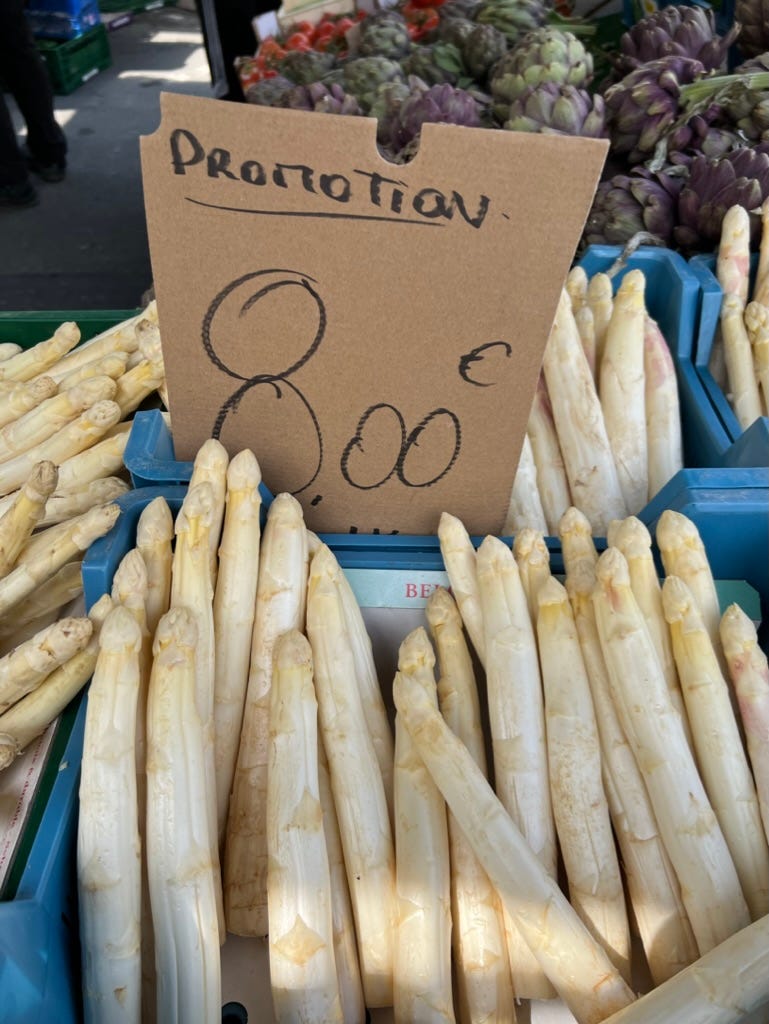
Most people are familiar with the purplish green shoots of asparagus. But the great white asparagus of northern Europe is a delicacy I can’t pass up. While wasting time last week in the Eataly off Madison Square, I happened on some gorgeous, big, fat white spears imported from Holland. The white variety, known in German as spargel, is blanched under soil, like endives in Belgium, to keep chlorophyl from developing. This gives white asparagus a more complex, slightly bitter flavor, juicy texture, and distinct albino appearance.
Whichever color asparagus you buy, if its diameter is more than 1/4 inch, I insist you peel it. The notion of snapping the stem where it breaks “naturally” is a wasteful folly to me. Peel your asparagus to reveal the tender, sweet flesh that runs the entire length of the stalk beneath any fibrous, woody exterior; the longer the better.
Back in 1990, when I did a month-long stage at La Tour d’Argent in Paris—still with its three Michelin stars at the time—giant asparagus the size of a child’s arm was the most precious ingredient in a kitchen full of truffles, foie gras, caviar, and edible gold. Only the sous chefs were allowed to peel them for fear of breaking the stems. These impressive limbs were served classically, steamed, dressed with hollandaise, and presented tableside on silver trays adorned with large gondolas made from gold-colored napkins. For special occasions at the restaurant—often private weddings for wealthy Americans—white asparagus made an appearance on the menu.
“Why do Americans love white asparagus so much?” the sous chef asked me one day, implying the French preference for green. I’d never seen them before, so what did I know? “They are exotic,” I replied.
Saturday, I served those large, white imported asparagus I brought back from NYC to guests at dinner, among them farmer friends from our beloved Edgewater Farm down the road. They’d never heard of, seen, or tasted white asparagus before. A lively conversation ensued. Exotic and delicious, indeed.
You can treat asparagus in a variety of ways, as you would just about any green vegetable. But because they are seasonal and have such a distinct flavor—just ask Nate—I usually choose to let them be the star of their own show. A light mustard vinaigrette or simple miso butter (50/50 soft butter to white miso), a sprinkling of chopped egg, some minced parsley, crispy fried shallots, salt, pepper, and a squirt of lemon—what the French might call à la mimosa—are my go-to garnishes. Add scallions, minced capers, some dill, anchovy paste, a splash of sesame oil and/or soy, as you like.
Despite the Spanish predilection for mushy canned asparagus, both green and white, which they are willing to pay a lot of money for, I advise you not to overcook them. They should be neither soft nor hard, but give to the gentle pressure of a butter knife. I like to cook them in shallow, salted water in a large pan so they can lay flat, covered tightly so they sort of boil/steam. They are so good.
RECIPE: Asparagus à la Mimosa
Serves as many as you need it to
1 to 2 pounds fresh asparagus or as much asparagus, as much as you need, the longer and thicker the spears, the better, imho
Sea salt
1/4 cup or more basic Dijon vinaigrette (see Issue #13) or miso butter (see Issue #2)
2 hard-cooked eggs, finely chopped
1/4 cup or more crispy fried shallots or onions
1/4 cup or more chopped parsley and/or other herbs, such as scallions, chervil, mint, dill
Juice of 1/2 lemon
Flaky salt and freshly ground,coarse black pepper
To peel asparagus, begin by cutting off the tough bottoms, about an inch will do. Lay a spear flat on a cutting board, holding the delicate tip just off the edge between the finger and thumb of your nondominant hand. With your dominant hand, use a sharp vegetable peeler to make long strokes, not pressing too hard, from about two inches below the tip to the bottom, removing strips of fibrous peel. Rotate the spear and continue stripping the peel. Don’t press or pull the peeler too hard or you’ll snap off the stem. Repeat with the remaining asparagus until all the spears are peeled, keeping them aligned in the same direction to ease cooking and presentation later.
In a large frying pan with a tight-fitting lid, bring to a boil about an inch of water. Add a generous pinch of sea salt. Add the asparagus, all facing the same direction. It doesn’t matter if they aren’t all in the water; they will steam. Cover and let cook about 5 to 7 minutes, depending on how thick they are. Remove the lid and poke them with the tip of a paring knife to test for doneness. You want them cooked but neither soft nor crisp. When done, use tongs to carefully lift and drain them, and then arrange them on a serving dish in an elegant pile.
Spoon the vinaigrette or miso butter over the warm spears. Garnish with the chopped egg, fried shallots, and parsley. Squeeze some lemon juice around the asparagus and sprinkle with flakey salt and freshly ground pepper to serve.
A Note About Storing Asparagus
The best way to store asparagus is standing at attention in shallow water. As soon as you get home from the store, if the ends are tough and dry, cut about an inch off and place the spears upright in a container with an inch or so of water and store in the fridge until ready to use. They will stay fresh for about two weeks.
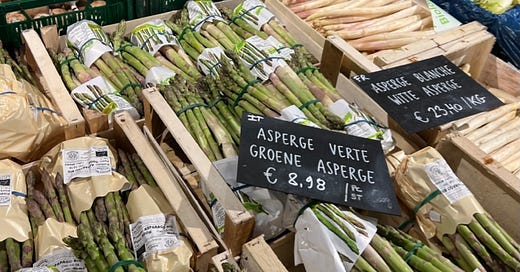



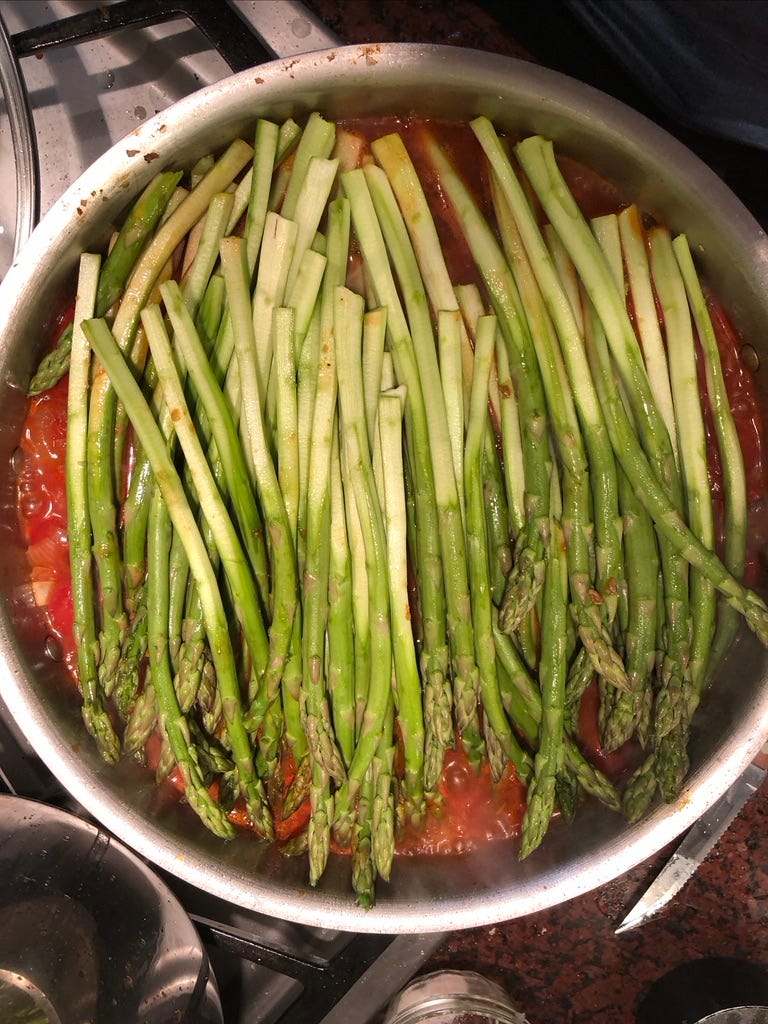

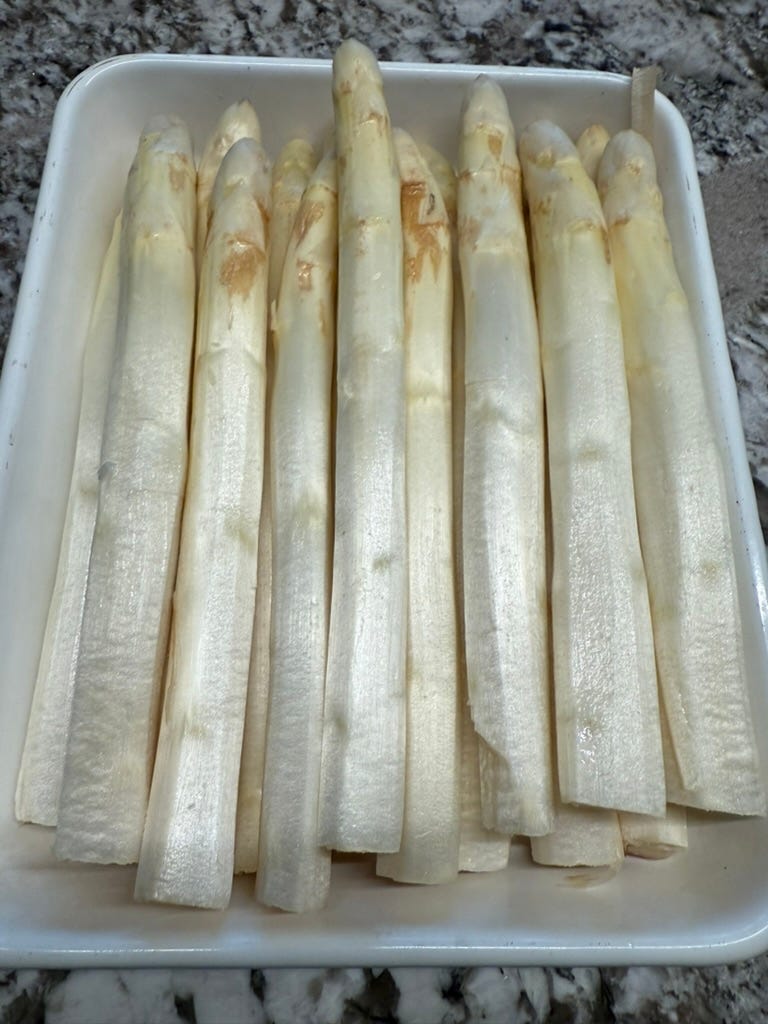
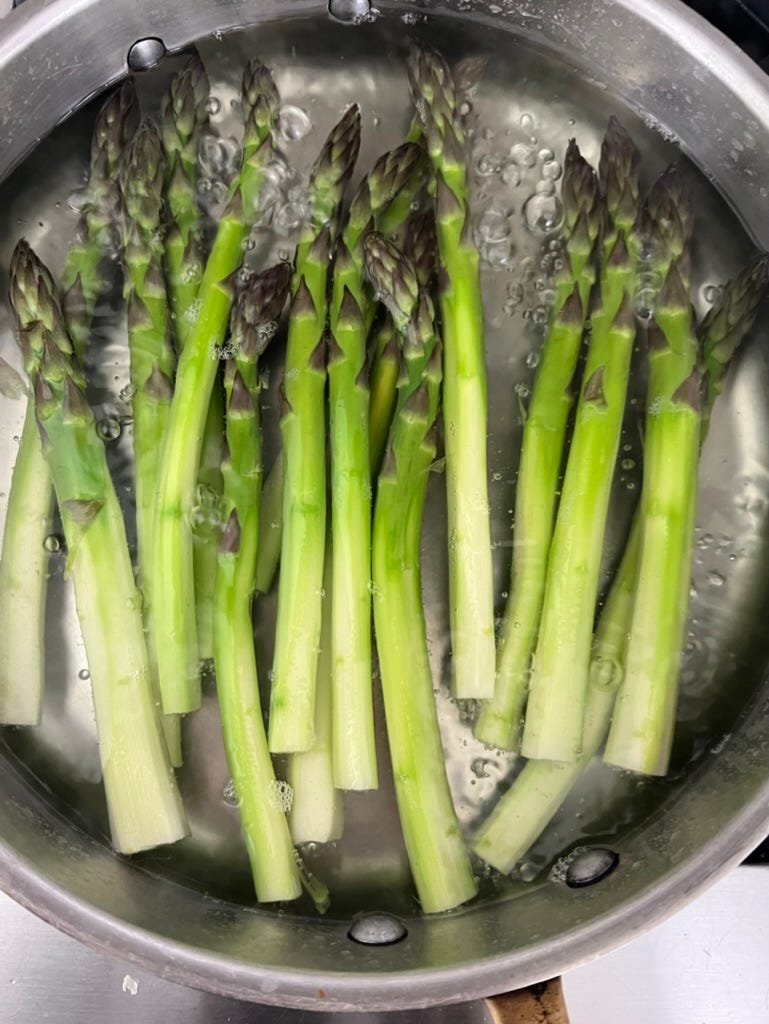
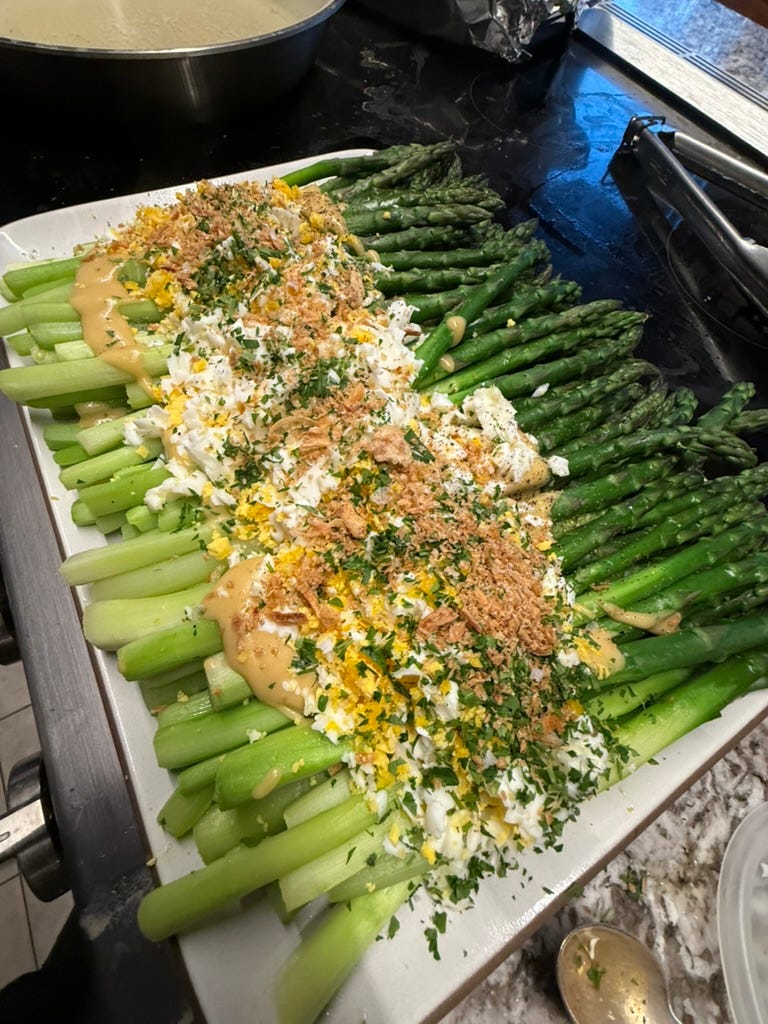
The amazing Mildred💕